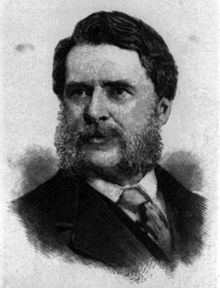Name John Johnston | Role Businessman | |
 | ||
Occupation Businessman, lawyer, philanthropist Similar People George Palmer Putnam, Eastman Johnson, Michael Jaharis, David Koch, Fred C Koch | ||
John Taylor Johnston was an American businessman and patron of the arts. He served as President of the Central Railroad of New Jersey and was the founding president of The Metropolitan Museum of Art.
Contents
Early years and personal life
John Taylor Johnston was born on April 8, 1820, the eldest child of John Johnston, a prominent businessman (of Boorman, Johnston, & Co.) and patron of the arts in New York City, and Margaret Taylor Howard, widow of Rhesa Howard, Jr., nephew of William Few, Signer of the U.S. Constitution from Georgia whose brother-in-law was U.S. Secretary of the Treasury Albert Gallatin. Besides first marrying the nephew of Founding Father William Few, Margaret Taylor Howard Johnston had four siblings who likewise married two grandchildren, a great-granddaughter, and a nephew of Founding Father Roger Sherman, Signer of the U.S. Constitution and the U.S. Declaration of Independence from Connecticut; other close relatives-by-marriage of Margaret Taylor Howard Johnston were instrumental in the founding of America and its religious and educational institutions.
Both of his parents were of Scottish ancestry. He was born and grew up in Greenwich Village, and was educated at Edinburgh High School in Edinburgh, Scotland. Johnson graduated from the University of the City of New York, an institution founded by his father and several other civic-minded New Yorkers, in 1839. He later studied at Yale Law School (where his classmates included Charles Astor Bristed, Daniel D. Lord, and Henry G. DeForest) and was admitted to the bar in 1843.
Johnston was married in 1851 to Frances Colles (1826-1888), the daughter of James Colles (1788-1883), a prominent merchant in New York and New Orleans, and Harriet Wetmore Colles (1795-1868). Their children were Emily (Mrs. Robert W. de Forest), Eva (Mrs. Henry E. Coe), Frances (Mrs. Pierre Mali), and John Herbert Johnston. In 1856, Johnston constructed the first marble mansion in New York as his residence at 8 Fifth Avenue, just north of Washington Square.
Johnston was an active diarist, recording details of his travels through Europe and the United States as well as significant personal and world events, including his wedding excursion, trips with his family, a visit to Richmond, Virginia in 1865 after the surrender of the Confederate Army, and a trip west on the newly built Union Pacific Railroad.
Career and philanthropy
Johnston practiced law until 1848, when he was named president of the Somerville and Easton Railroad (later the Central Railroad of New Jersey), a position he would retain until 1877. Johnston was the driving force behind the company's acquisition of the Lehigh and Susquehanna Railroad, and also endeavored to develop the suburbs of central New Jersey through which his railroads passed. According to his obituary, "[h]is expenditures to secure low grades and good alignment to avoid grade crossings were far in advance of the railroad science of his time and were ridiculed by some of his competitors."
Johnston was the founding president of the Metropolitan Museum of Art in 1870. Together with William Tilden Blodgett he financed the initial "1871 purchase" of 174 paintings for the museum. He held this position until ill health forced him to retire in 1889, at which point he was succeeded by Henry Gurdon Marquand. He was an avid collector and patron of the arts, collecting French academic painting and serving as a patron to living American artists. His holdings included works by Frederic Edwin Church, Thomas Cole, Asher Brown Durand, John Frederick Kensett, and Winslow Homer. His personal art collection, located in his Fifth Avenue mansion, was open once a week to the public.
In addition to his patronage of the arts, Johnston served as President of the Governing Board of the University of the City of New York, and as a member of the boards of the Presbyterian Hospital, the Woman's Hospital of New York, and the Saint Andrew's Society. He was also a member of the Century Association, and a trustee of the American Museum of Natural History and the National Academy of Design.
Death and legacy
In his later years, Johnston was afflicted with creeping paralysis (possibly multiple sclerosis) and withdrew from public life. He died at his Fifth Avenue estate in New York City on March 24, 1893. His funeral was held at the Scotch Presbyterian Church (now the Second Presbyterian Church) in New York, of which he was an elder, and he is interred at Greenwood Cemetery. In his will, he left $10,000 each to the University of the City of New York and The Metropolitan Museum of New York.
Johnston's name recalls the era when Bergen Neck was dominated by rail infrastructure.
Johnston Avenue in lower Jersey City, New Jersey (designated County Route 614 for a 0.81-mile (1.30 km) section of its length) begins in the west at the foot of Bergen Hill close to Communipaw Junction and ends at the Liberty State Park Station of the Hudson Bergen Light Rail. The cobblestoned portion street continues under New Jersey Turnpike Newark Bay Extension, in Liberty State Park to the Communipaw Terminal on the Upper New York Bay and in the 1970s was rededicated Audrey Zapp Drive to honor a local environmentalist influential in the development of the park.
The Port Johnston Coal Docks on Constable Hook in Bayonne, New Jersey, also bear his name. The former Johnston Avenue Yard was the terminus for the Lehigh Valley Terminal Railway.
After retiring as President of The Metropolitan Museum of Art in 1889, the institution’s Trustees subsequently voted him Honorary President for Life.
Through his daughter Frances, Johnston is the great-great-grandfather of American slam poet Taylor Mali.
